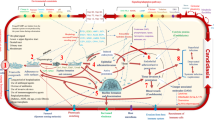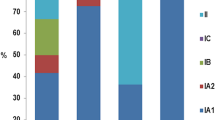Abstract
Phenotypic variants of parent strains ofChaetomium globosum, Trichophyton terrestre, Rhodotorula rubra, andSaccharomyces cerevisiae were exposed to pooled salivary samples contributed by healthy individuals and three groups of outpatients receiving radiation treatment for malignancies, protracted corticosteroid regimes for renal complications, and insulin therapy for diabetes mellitus. Significant variations occurred in fungal growth rates according to phenotype association with specific salivary samples.
Similar content being viewed by others
References
Austin, L. B. & B. J. Zeldow (1961) Quantitative changes of a human salivary bactericidin for lactobacilli associated with age. Proc. Soc. Exp. Bio. Med. 107: 406–408.
Bibby, B. G., O. W. Clough & M. K. Hine (1938) The antibacterial action of human saliva. J. Amer. Dent. Assoc. 25: 1290–1302.
Dogon, I. L. & B. H. Amdur (1970) Evidence for the presence of two thiocyanate-dependent antibacterial systems in human saliva. Arch. Oral Biol. 15: 987–992.
Dogon, I. L. & B. H. Amdur (1965) Further characterization of an antibacterial factor in human parotoid secretions active against Lactobacillus casei. Arch. Oral Biol. 10: 605–615.
Dogon, I. L., A. C. Kerr & B. H. Amdur (1962) Characterization of an antibacterial factor in human parotid secretions active against Lactobacillus casei. Arch. Oral Biol. 7: 81–90.
Green, G. E. (1959) A bacteriolytic agent in salivary globulin of caries-immune human beings. J. Dent. Res. 38: 262–275.
Kerr, A. C. & D. L. Wedderburn (1958) Antibacterial factors in the secretions of human parotid and submaxillary glands. Brit. Dent. J. 105: 321–326.
Klebanoff, S. J. (1968) Myeloperoxidase-halide-hydrogen peroxide antibacterial system. J. Bact. 95: 2131–2138.
Klebanoff, S. J. & R. G. Luebke (1965) The anti-lactobacillus system of saliva. Role of salivary peroxidase. Proc. Soc. Exp. Biol. Med. 118: 483–486.
Lehrer, R. I. (1969) Antifungal effects of peroxidase systems. J. Bact. 99: 361–365.
Thompson, R. (1941a) Lysozyme and the antibacterial properties of tears. Arch. Ophthalmol. (Chicago) 25: 491–509.
Thompson, R. (1941b) Certain antibacterial properties of saliva and tears not due to lysozyme. J. Bact. 41: 77.
Thompson, R. (1940) Lysozyme and its relation to the antibacterial properties of various tissues and secretions. Arch. Pathol. 30: 1096–1134.
Trinci, A. P. J. (1971) Influence of the width of the peripheral growth zone on the radial growth rate of fungal colonies on solid media. J. Gen. Microbiol. 67: 325–344.
Van Kesteren, M., B. G. Bibby & G. P. Berry (1942) Studies on the antibacterial factors of human saliva. J. Bact. 43: 573–583.
Volz, P. A., Y. C. Hsu, J. L. Hiser, J. M. Veselenak & D. E. Jerger (1973) The Microbial Ecology Evaluation Device mycology spaceflight studies of Apollo 16. Mycopath. Mycol. Appl. (Pub. no M2945, in press).
Volz, P. & M. Dublin (1973) Filamentous fungi exposed to spaceflight stresses including known levels of ultraviolet irradiations. Space Life Sciences (in press).
Zeldow, B. J. (1961) Studies on the antibacterial action of human saliva. II. Observations on the mode of action of a lactobacillus bactericidin. J. Dent. Res. 40: 446–453.
Zeldow, B. J. (1959) Studies on the antibacterial action of human saliva. I. A bactericidin for lactobacilli. J. Dent. Res. 38: 798–804.
Zeldow, B. J. (1955) Antibacterial activity of mixed and parotid human saliva. A preliminary report. J. Dent. Res. 34: 737.
Author information
Authors and Affiliations
Rights and permissions
About this article
Cite this article
Dublin, M., Volz, P.A. & Bulmer, G.S. The antifungal activity of normal and host-compromised saliva on spaceflight fungal phenotypes. Mycopathologia et Mycologia Applicata 54, 499–516 (1974). https://doi.org/10.1007/BF02050055
Accepted:
Issue Date:
DOI: https://doi.org/10.1007/BF02050055




